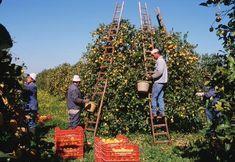
Consumption of Italian fruit is on the wane. One of the main reasons for this is the dwindling popularity of Italian standard light-coloured varieties of oranges. These struggle in the face of competition from Spain not just on export markets but even on the domestic Italian market. The market prefers the larger sizes for fresh production while smaller sizes head for the processing sector.
On easy-peel, Italy’s exports are mainly to eastern European countries and are fairly stable. Volumes for the domestic market are supplemented by arrivals from Spain and production is mainly of clementine types. There is growing preference in Italy for seedless fruit.
Lemon production is experiencing minor reductions in area but a larger decline in volumes harvested year on year. The main reason is the low level of orchard renewal in the lemon sector and consequently ageing, and lower bearing plant material. The volumes of lemons headed for the processing market are growing as consumption of the fresh product declines and that market sector now absorbs almost a third of the national crop.
But Italians are seeking to diversify production and export markets by taking advantage of unique production conditions and fruit characteristics to achieve protected geographical indicator (PGI) status from the European Union for several citrus products.
One among these is the renowned blood orange from Sicily. Producer Organisation Rossa di Sicilia can take much of the credit for gaining this distinction and it appears to be paying off. Demand for blood oranges is increasing both for the fresh market and for processing. The PGI is effectively adding value and consumers are moving towards this type rather than their fair-skinned cousins thanks to a perception that they are healthier.
Demand in the UK appears to be on the increase too, thanks to the quest for ever tastier and more colourful fruit-juice mixes. This is also boosting the domestic processing industry on the island of Sicily.
The main blood-orange types grown in Italy are Tarocco, which accounts for about 59 per cent of Italy’s entire orange crop, Moro and Sanguinello. Fruit sizes tend to be smaller than non-pigmented types and production costs are higher due to lower productivity. But prices are higher and so is profitability: farm gate prices for blood oranges, monitored by agricultural authorities, were almost double those of non-pigmented types such as navel and Valencia Late as well as the native Italian type Ovale.
It is not just oranges that are responding to an increasingly difficult global market by adding value and diversifying export markets in this way. Calabria, along with Sicily part of the citrus belt of Italy, has PGI status for its clementines boosting their standing both on domestic and export markets. And there are two PGIs for Italian lemons one for the Costa d’Amalfi and one for Sorrento.
OPAC FIGHTS BACK
Eastern-Sicily based producer organisation Antonino Campisi (Opac) is one of Italy’s leading citrus groups. A co-operative society, it brings together 70 growers who cultivate a range of fruit and vegetables including lemons and oranges. Some 400ha of its 700ha are given over to citrus production.
Opac’s main market is the domestic one, although it also has an important export business to Germany, Austria, the UK, France and Switzerland. The organisation employs six administrative staff and a further 40 in its 5,000m2 storage and packing operation.
The organisation believes in investment in the latest technology in order to enhance efficiency and quality and, for example, has recently purchased new grading equipment which selects fruit using fibre-optic technology according to size, colour and weight as well as a flow-wrapper to pack lemons in over-wrapped trays of four fruits.
Lemons account for 30 per cent of Opac’s turnover and oranges 20 per cent. The supermarkets are Opac’s main customers by far taking 90 per cent of its fresh market production; 70 per cent to Italian chains and 20 per cent exported to multiples elsewhere in the EU. Of the remainder, a fifth is exported to European wholesale markets and the rest is channelled to the Italian wholesale sector.
“The UK market occupies a very important place in the growth and development of our business,” says Dario Campisi, vice-president at Opac, “for citrus and for salads and vegetables. We hope to be able to increase our commercial ties with product specially selected for the UK market. We are fully aware of the demands of the market in terms of BRC and Eurep-GAP standards and these act as a stimulus for us to do our best and meet the objectives.” The organisation’s citrus operations are expected to be granted ISO9000 certification soon. It is also geared up in terms of its packhouse operations to provide configurations adapted to market demands.
While competition from Spain, Morocco, Tunisia and Israel made its presence felt on the Italian citrus sector some time ago, organisations such as Opac have realised that while they cannot compete on price due to lower labour, transport and packing costs, they can compete on quality. “That is to say that Italian legislation is a lot more restrictive than many other countries when it comes to the use of crop-protection products and so we grow using methods that have as little impact as possible on the environment and human health,” says Campisi.
Looking to the future, Opac believes in differentiation. “We are looking at new branding-type strategies for traditional products that guarantee high quality standards,” says Campisi. “And to this end, we hope a Syracuse lemon consortium will soon be established as a real force. Agriculture in Italy is a tough business so we should be wary of those who try and provide good quality products at low cost because those two parameters are not always compatible.”



